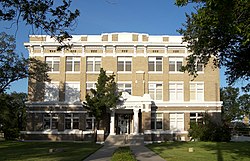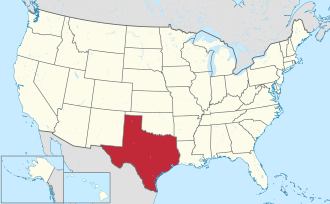Kleberg County | |
|---|---|
 The Kleberg County Courthouse in Kingsville. The building was added to the National Register of Historic Places on May 10, 2010. | |
 Location within the U.S. state of Texas | |
 Texas's location within the U.S. | |
| Coordinates: 27°26′N97°40′W / 27.43°N 97.66°W | |
| Country | |
| State | |
| Founded | 1913 |
| Named after | Robert J. Kleberg |
| Seat | Kingsville |
| Largest city | Kingsville |
| Area | |
• Total | 1,090 sq mi (2,800 km2) |
| • Land | 881 sq mi (2,280 km2) |
| • Water | 209 sq mi (540 km2) 19% |
| Population (2020) | |
• Total | 31,040 |
| • Density | 28/sq mi (11/km2) |
| Time zone | UTC−6 (Central) |
| • Summer (DST) | UTC−5 (CDT) |
| Congressional district | 34th |
| Website | www |
Kleberg County is a county in the U.S. state of Texas. As of the 2020 census, its population was 31,040. [1] The county seat is Kingsville. [2] The county was organized in 1913 [3] and is named for Robert J. Kleberg, an early settler.
Contents
- History
- Geography
- Major highways
- Adjacent counties
- National protected area
- Demographics
- 2020 census
- 2000 Census
- Religion
- Communities
- Cities and towns
- Census-designated places
- Unincorporated community
- Politics
- Education
- See also
- References
- External links
Kleberg County is part of the Kingsville, TX Micropolitan Statistical Area, which is also part of the Corpus Christi-Kingsville-Alice, TX Combined Statistical Area. Most of the county's land lies in the famed King Ranch, which also extends into neighboring counties.
